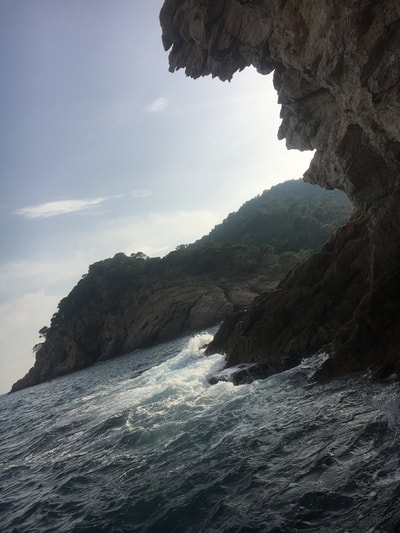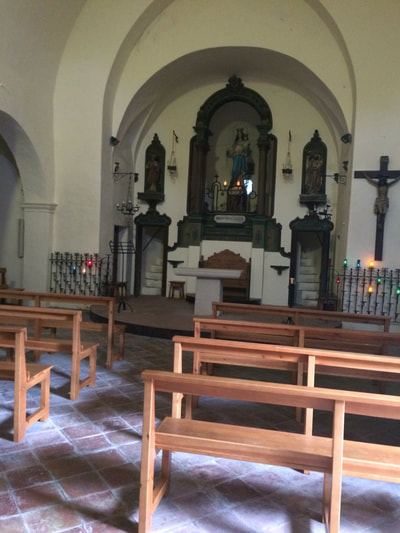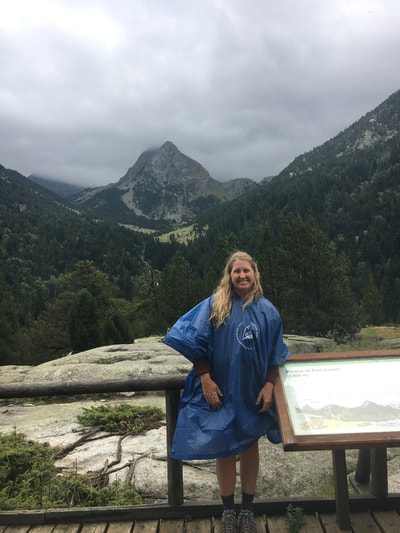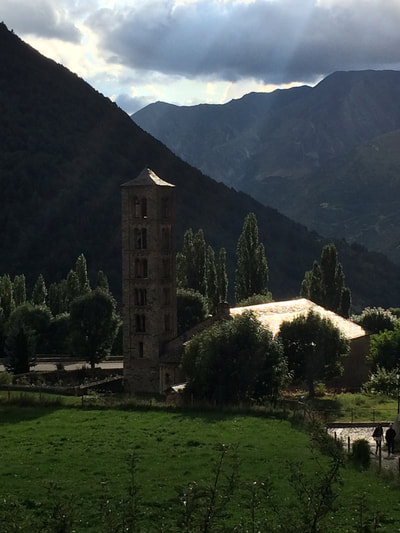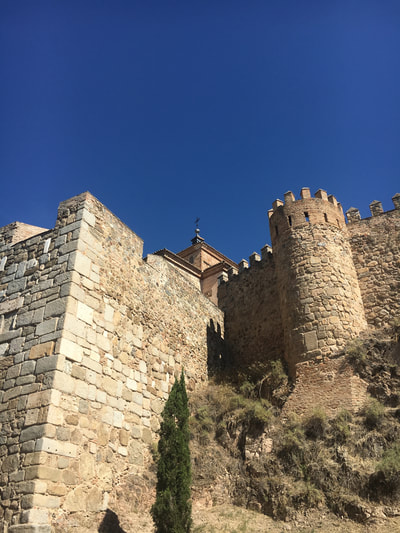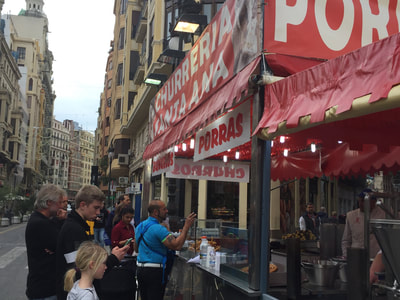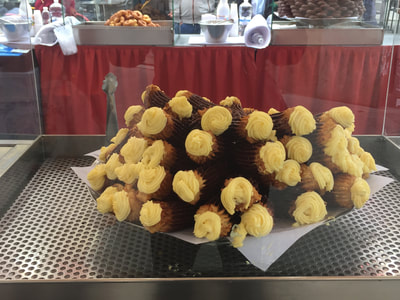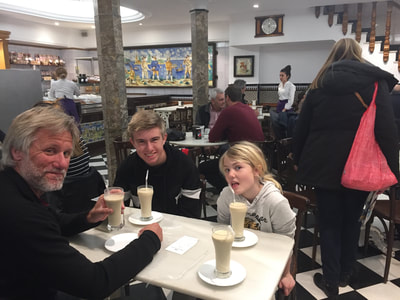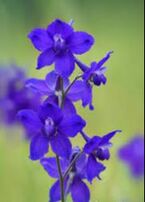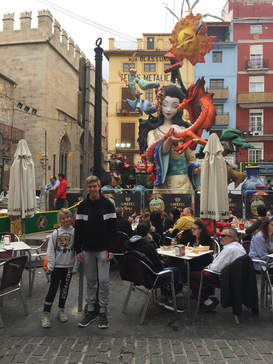 Just like holidays everywhere, part of the fun is the lead up. There are very specific traditions that accompany Las Fallas that the local residents do before the more than 1 million visitors descend on Valencia for the actual three days of Las Fallas. Las Fallas can be daunting for a newcomer because of the vast number of activities, some of which are only meant for the people in the Fallas Communities, so it's hard to know what to do. It also takes one full Las Fallas to understand what things mean and the order things happen. And, finally, calendars of activities are in Spanish or Valencian and not always updated. Thanks to our Spanish friends, we got a complete list of the things we should do before Las Fallas began. Although our high school son, Carson, took full advantage of staying out in Valencia until 3:00 am with all the other highschoolers, it was nice to participate in other activities that fit my nine year old daughter's schedule (and frankly, mine, as well). 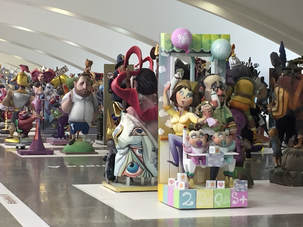 1. Voting on Ninots. Every Fallas monument is made up of many ninots. These are the smaller sculptures that surround, or are part of, each large Fallas. The City of Arts and Sciences hosts a display of ninots from every Fallas that will be burned on the streets of Valencia on the final night of La Crema. These ninots are usually about the height of a person and very intricate. Often they are a smaller version of a Fallas, or represent the general theme. There are over 350 of these ninots on display in a room that looks like a Convention Center. Everybody that comes in receives a ticket that enables them to vote on their favorite ninot. The winner is announced during Las Fallas and is saved from the fires. It will be displayed in the Fallas Museum, a museum opened year-round that displays the ninot winners from each year of Las Fallas. 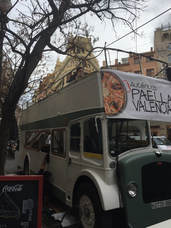 2. Street Vendors, Horchata, and Bunyols. One of the best things about Las Fallas is the food (or should I say the treats). Street venders set up all over Valencia and serve specialty pastries that can't be found during any other time of year. One of the favorites is a cone of pumpkin bunyols with dipping chocolate. They are like fritters - light fried dough with sugar sprinkled on top. The other favorite is a stuffed churro (a little too rich for me). Churros are stuffed with vanilla or chocolate cream. and can be dipped in chocolate. Eating just one of these provides one's maximum sugar intake for the week. In addition, there are temporary paella and bocadilla stands, as well as beer and horchata carts. Enforcing a drinking age is very lax during Las Fallas (really, it always is). My son's friend, who is 15, ordered a bocadilla that came with a drink at one of the local carts. He tried to get a coke, but was told that he would have to have a beer, since that was the deal. Horchata is the traditional drink of Spain, and is a focus during Las Fallas. It is a creamy, sweet drink made of tiger nuts, very different from Mexican horchata, which is made from rice milk. The most famous place in Valencia to drink horchata is the Horchateria Catalina. It is in the old town portion of Valencia and has been in operation since 1909. During Las Fallas, they are equipped for a steady stream of customers. It is atmospheric and the horchata is delicious! 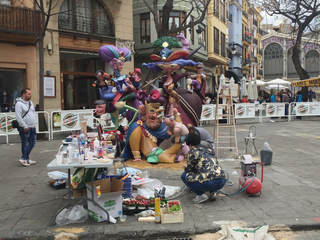 3. Watching the Fallas Go Up. The thing I enjoyed the most was going in to Valencia a couple of days before Las Fallas began to wander the streets and look at the Fallas. Even though the deadline (or la planta) is the 15th of March, most groups have their Fallas up at the beginning of the week. In addition, they are setting up for the large parties for each Fallas Community, so there are kegs of beer and tents going up around each Fallas. This time is relaxing for spectators since the crowds haven't yet come. Many families take their younger kids in during this time. Every corner of Valencia may have a hidden Fallas erected, although the main ones are put in the Old Town plazas. By staying until dark, we were also able to see the lights strung across streets all through the neighborhoods. Each neighborhood has its own special light scheme that they bring out every year. 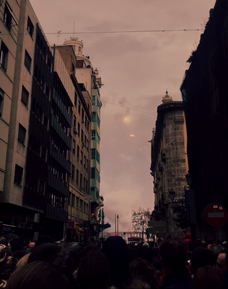 4. The Mascleta. I have mentioned the mascleta before, but it is really the focul point of Las Fallas, so much so that they begin about a month before the actual festival (any excuse for noise and fireworks). Every single day at 2:00, people gather for an audio fireworks show at the Plaza del Ayuntamiento (in front of the court house). A giant area is fenced off all through Fallas where the mascletas take place. The closer to actual Las Fallas, the bigger the crowds get. When we went on the first day of Las Fallas, it was so crowded that we couldn't get closer than a block away and everyone was packed together in the streets like sardines. But, it doesn't really matter since it's all about the noise and the billowing smoke that rises above the city. As the maslceta builds, the smoke slowly covers all the buildings so you are just looking at a wall of smoke. The mescleta actually surprised me. I was not looking forward to going because I hate loud noises and the "dud" fireworks that go off during the 4th of July. However, everyone here said that I had to go to at least one. But, I absolutely LOVED it and would have gone every day if I had known. I found it is not really just loud noises but a symphony of sound and rhythm that builds and builds. You hardly realize that the noise is booming because the constancy and the rhythm of it carries you away into what feels like a trance. It's almost as if everyone's hearts are beating together in time to the booming and you can feel the energy of the crowd building all around you. When it is over, everyone is smiling and I felt like I should be hugging people. It is a very unifying experience. 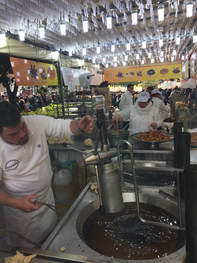 5. School Trips. Finally, one of the great things about our kids going to school here is that they got to learn a lot about Las Fallas (and therefore inform their parents). Each of our kids spent about a week before Las Fallas learning about it in their Spanish classes. Then, all the international students got to go into Valencia for a day to hear the mascleta, eat churros, walk around, and vote on the ninots. It helped us know the traditions of what to do when we went in as a family. Plus, you can't really beat roaming the streets of Valencia with your friends and a teacher from Spain. It's like being initiated into what it feels like to look forward to a festival each year, rather than as a one-time visitor. The school trips helped to demystify, a bit, this huge regional custom.
1 Comment
Sherron
3/25/2018 08:03:28 am
Amazing! Thank you for this last blog about Las Fallas and your activities. I enjoyed reading. :)
Reply
Leave a Reply. |
AuthorSally and her family moved to Spain for a year from July 2017 - July 2018. They lived in a little town called Puzol, which is about 20km north of Valencia. Her kids, Carson and Celia, attended the American School of Valencia, an International School located in Puzol. The goal for the whole family was to experience another way of life, and learn Spanish. Archives
May 2018
topics |
contact
|
